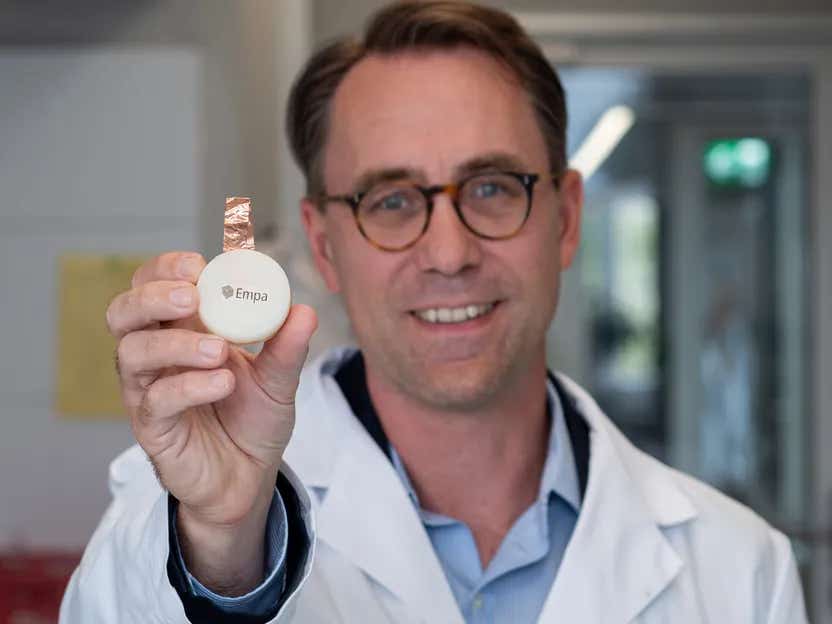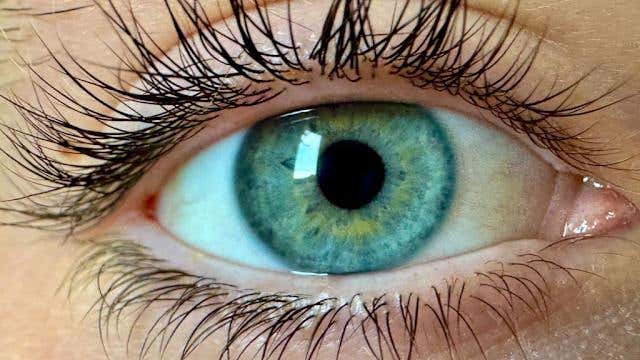New fungi-based battery needs feeding instead of charging
A 3D-printed fungal battery runs on yeast and wood-decay fungi, offering clean energy and full biodegradability.

Empa scientist Gustav Nystroem with the fungal battery that is encased in beeswax. (CREDIT: Empa)
Fungi may not seem like an obvious power source, but researchers have proven they can offer a sustainable and renewable way to generate electricity. Through a blend of microbiology, materials science, and electrical engineering, a new kind of battery—based entirely on living fungi and biodegradable materials—has come to life in the lab.
A Growing Problem, and a Natural Solution
Electronic waste is growing fast. By 2030, experts estimate that the world will generate nearly 75 million metric tons of it. Most of this e-waste includes parts that can't be recycled or safely broken down. This makes the need for greener, safer electronics more urgent than ever.
To address this, scientists have started turning to nature. One major breakthrough is the development of microbial fuel cells (MFCs), also known as biobatteries. These devices use the metabolic activity of microorganisms to produce energy.
Until now, most MFCs have relied on bacteria. But researchers at Empa’s Cellulose and Wood Materials Laboratory in Switzerland have found a way to make them work with fungi—organisms that are typically used in fermentation or for breaking down wood.
“For the first time, we have combined two types of fungi to create a functioning fuel cell,” said Carolina Reyes, one of the lead researchers at Empa.
Fungi Meet 3D Printing
This new biobattery doesn’t just rely on fungi—it is made with them. Using advanced 3D printing, scientists embedded living fungal cells into cellulose-based ink to build the components of the battery. These fungi aren’t added in afterward—they're printed right into the structure. This method makes sure the fungi have access to nutrients and can grow in the right places.
The 3D-printed ink includes cellulose nanocrystals and nanofibrils, carbon black, and graphite flakes. Together, these materials create a strong, biodegradable structure that also conducts electricity.
Related Stories
The two fungal species—Saccharomyces cerevisiae (a type of yeast) and Trametes pubescens (a white-rot fungus)—each serve a specific purpose. The yeast goes on the anode side, where it breaks down sugars and releases electrons. The white-rot fungus goes on the cathode side and produces enzymes that help capture and transfer those electrons.
The final design includes not only 3D-printed electrodes but also a biodegradable outer shell made from beeswax and a special cellulose-based proton exchange membrane (PEM). “It’s not only non-toxic, but also fully biodegradable,” said Gustav Nyström, who heads the Empa lab.
How the Fungal Battery Works
Microbial fuel cells create electricity by mimicking what all living organisms do—breaking down food to release energy. Inside the anode, the yeast fungus consumes sugar and releases electrons. These electrons move across a wire to the cathode, where they meet oxygen and create an electric current. A proton exchange membrane between the two sides allows hydrogen ions to pass while keeping oxygen out of the anode chamber. This process creates a small but steady flow of electricity.
In this study, a single fungal battery could produce a maximum power density of 12.5 microwatts per square centimeter and a peak current density of 49.2 microamps per square centimeter at a 22-kilohm load. On its own, one battery can generate between 300 and 600 millivolts for several days, delivering 3 to 20 microamps of current, depending on the load. When four of these batteries are connected in parallel, they can power a small environmental sensor for 65 hours straight.
“You can store the fungal batteries in a dried state and activate them on location by simply adding water and nutrients,” Reyes explained. That feature is especially useful for applications like remote sensing and agricultural monitoring, where access to electricity might be limited.
Why Fungi?
Fungi are surprisingly versatile. Though most people think of mushrooms or molds, fungi include everything from single-celled organisms to massive underground networks. In the natural world, white-rot fungi are known for breaking down tough materials like wood. That’s partly thanks to enzymes like laccase and cellobiose dehydrogenase, which can also help move electrons inside a battery.
Previous studies have shown that fungi can produce their own redox mediators—compounds that help transfer electrons to electrodes. Some yeasts, like Candida melebiosica, can even secrete their own electron-shuttling molecules into the surrounding fluid. In the new design, the two types of fungi bring these strengths together: the yeast supplies electrons, while the white-rot fungus helps capture them on the cathode.
This natural teamwork increases the efficiency of the microbial fuel cell and expands its possible uses. So far, fungal MFCs have not been explored as deeply as bacterial ones, making this new approach a fresh direction in the world of green electronics.
Beyond the Lab: Future Possibilities
MFCs in general have been explored for various uses, from treating wastewater to powering small devices. They've even been used to drive microprocessors and clean up toxic dyes. But the use of biodegradable and renewable materials in these systems has often been limited.
That’s what makes the Empa team's work stand out. Their design is based entirely on non-toxic and degradable parts—no heavy metals, no synthetic plastics. This makes them safer for both humans and the planet.
Their cellulose-based ink, for example, isn’t just a passive building material. It can be metabolized by the fungi after the battery’s useful life ends, helping the whole device break down naturally. This focus on sustainability extends to every part of the design, from the beeswax enclosure to the plant-derived membrane.
3D bioprinting also offers other benefits. It lets researchers control the shape, size, and inner structure of the battery’s components, which can improve how the cells grow and how efficiently they work. “It is challenging enough to find a material in which the fungi grow well,” Nyström said. “But the ink also has to be easy to extrude without killing the cells—and of course we want it to be electrically conductive and biodegradable.”
The Road Ahead
The fungal battery is still in its early stages. The amount of electricity it produces is small, but enough to power low-energy sensors for environmental or medical use. The team plans to improve its performance and test other types of fungi that might work even better.
The work was made possible by the Gebert Rüf Stiftung’s Microbials funding program and reflects a broader movement toward clean, safe, and renewable energy. “Fungi are still under-researched and under-utilized, especially in the field of materials science,” Reyes said. But this project shows how much promise they hold.
In a world drowning in toxic waste and struggling with climate change, the idea of living batteries made from fungi and plants might sound strange—but it's also a smart, elegant solution hiding in plain sight.
Research findings are available online in the journal ACS Sustainable Chemistry & Engineering.
Note: The article above provided above by The Brighter Side of News.
Like these kind of feel good stories? Get The Brighter Side of News' newsletter.
Joseph Shavit
Head Science News Writer | Communicating Innovation & Discovery
Based in Los Angeles, Joseph Shavit is an accomplished science journalist, head science news writer and co-founder at The Brighter Side of News, where he translates cutting-edge discoveries into compelling stories for a broad audience. With a strong background spanning science, business, product management, media leadership, and entrepreneurship, Joseph brings a unique perspective to science communication. His expertise allows him to uncover the intersection of technological advancements and market potential, shedding light on how groundbreaking research evolves into transformative products and industries.



